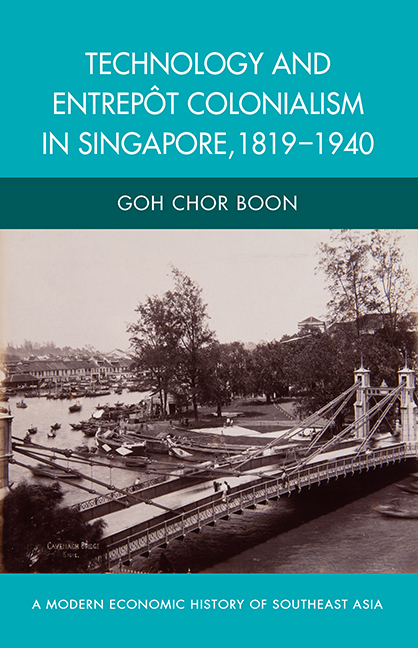Book contents
- Frontmatter
- Contents
- List of Figures and Tables
- Notes on Currency
- Introduction
- 1 Technology and the British Empire
- 2 Pioneers of Change: Entrepreneurs and Engineers
- 3 Maritime Technology and Development of the Port
- 4 Introducing Technological Systems
- 5 Sanitation and Public Health
- 6 Agriculture and Colonial Science
- 7 Food and Singapore Cold Storage
- 8 Politics of Imperial Education
- 9 Technology Transfer and Limited Industrial Growth
- Conclusion
- Bibliography
- Index
3 - Maritime Technology and Development of the Port
Published online by Cambridge University Press: 21 October 2015
- Frontmatter
- Contents
- List of Figures and Tables
- Notes on Currency
- Introduction
- 1 Technology and the British Empire
- 2 Pioneers of Change: Entrepreneurs and Engineers
- 3 Maritime Technology and Development of the Port
- 4 Introducing Technological Systems
- 5 Sanitation and Public Health
- 6 Agriculture and Colonial Science
- 7 Food and Singapore Cold Storage
- 8 Politics of Imperial Education
- 9 Technology Transfer and Limited Industrial Growth
- Conclusion
- Bibliography
- Index
Summary
A close relationship existed between the expansion of the British Empire and British scientific exploration of lands beyond. In the nineteenth century, geography became a significant “imperial science” in British schools and universities. Exploration and map compilation in far-flung regions remained a source of enormous public interest but as geography developed in to a professional discipline, it “began to expand beyond its original focus on exploration and topographical map-making to assume intellectual authority over a wide range of regionally specific environmental, economic, social, political and cultural evidence”. Both the amateur explorers and the university-based scholars provided the geographical knowledge necessary for overseas conquest and colonization. The Empire, with its extensive material resources and geographical reach, allowed travellers and scientific explorers to sail into nooks and corners of lands in the periphery and pursue their interests on a genuinely global scale. The expeditions of James Cook, Joseph Banks and Joseph Conrad resulted in huge collections of scientific information which contributed to the development of British science. The gathering of such knowledge relied on a set of institutions closely linked to the imperial government, including the Admiralty, the Hydrographer's Office, the East India Company, the Royal Engineers, the Ordinance Survey, the Geological Survey and the Kew Gardens. The island of Singapore appeared on a variety of regional maps with the Europeans making inroads into the seas and lands of Southeast Asia from the sixteenth century. Charting of the Straits of Malacca and the adjacent coastline, including the Straits of Singapore, was an important preoccupation for the Portuguese, the Dutch, and, the English. “[B]y the 1550s or so map-making had begun to catch up with the pace of exploration and discovery in South-east Asia” and cartographers, hydrographers, naturalists and explorers of many European nationalities, such as Ferdinand Magellan, Francis Drake, Joris van Spilbergen, Jan van Linschoten, William Dampier, James Cook, John Crawfurd and James Horsburgh contributed immensely to the knowledge of the region depicted on contemporary maps. It is not surprising then that Stamford Raffles was armed with the geographical knowledge of the region which allowed him to make critical choices in setting up a British station. Soon after the island was ceded to Britain in 1819, Captain Franklin surveyed the southern coastline.
- Type
- Chapter
- Information
- Publisher: ISEAS–Yusof Ishak InstitutePrint publication year: 2013

